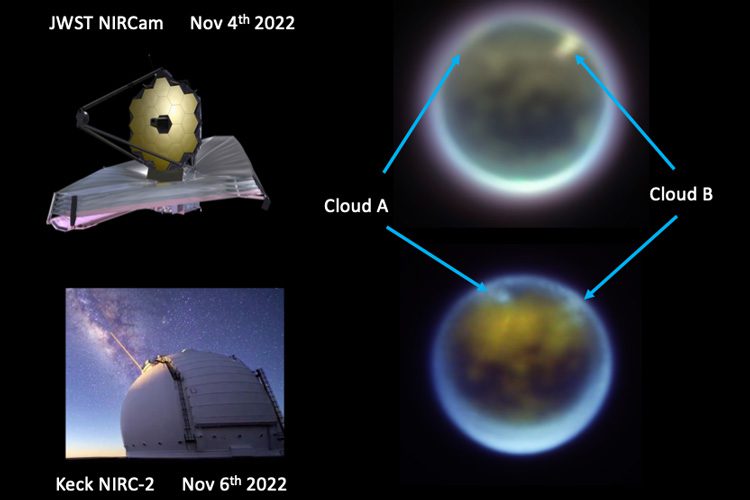Titan is the only other body in the Solar System with seas, rivers, and lakes – although they’re not made of water, but hydrocarbons, such as methane. Its unique properties are worth studying in detail, and given that the Cassini mission is no longer exploring Saturn, is up to telescopes to keep an eye on it. Both JWST and the Keck observatory here on Earth have now studied the frigid world, with incredible results.
The two world-class telescopes were able to see the seas of Titan, as well as clouds. JWST images were taken on November 4. The team noticed two clouds in the atmosphere near the North Pole of the moon. Researchers were interested to know if they could track the evolution of these clouds; they were able to secure observing time at Keck, and saw them again 30 and 54 hours later.
“We were concerned that the clouds would be gone when we looked at Titan one and two days later with Keck, but to our delight there were clouds at the same positions, looking like they might have changed in shape,” Imke de Pater, a University of California, Berkeley professor, said in a statement.

The evolution of the clouds on Titan over 30 hours. Image credit: NASA/STScI/Keck Observatory/Judy Schmidt)
While the images from space and ground might not look too dissimilar, the power and the advantage of JWST is in the suite of instruments, such as its spectrometers, that can provide more details about the composition of the atmosphere, as well as the height of the clouds and the elevation of the haze.
“By using spectrometers on JWST together with the optical image quality with Keck, we get a really complete picture of Titan,” added de Pater, who collaborated on the observation with team lead Conor Nixon.
Titan is the only moon in the solar system with such a dense atmosphere. In 2027, NASA will send a new mission to Titan. It’s called Dragonfly, and it will be a multirotor lander that can assess if the moon, with its weird chemistry, could be habitable for some lifeforms.
“This is some of the most exciting data we have seen of Titan since the end of the Cassini-Huygens mission in 2017, and some of the best we will get before NASA’s Dragonfly arrives in 2032,” said Zibi Turtle of Johns Hopkins University, who is Dragonfly’s principal investigator. “The analysis should really help us to learn a lot about Titan’s atmosphere and meteorology.”
The data from these observations is still being analyzed and has not been published.
Source Link: JWST And Keck Spot Clouds And Even A Sea on Saturn’s Titan